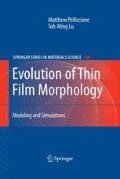As was discussed in the previous chapter, solid-on-solid models are ones where no overhangs are allowed on the simulated surface. These models are the simplest to implement because the height profile is a single-valued function of position, and as a result, are the most common discrete models utilized in modeling thin film growth. More complicated models, including ballistic aggregation models, have been of interest as well, but illustrating the formulation and use of solid-on-solid models first gives insight into the advantages and drawbacks of both types of models. For more discussion regarding solid-on-solid models, see [40].
Access this chapter
Tax calculation will be finalised at checkout
Purchases are for personal use only
Preview
Unable to display preview. Download preview PDF.
Rights and permissions
Copyright information
© 2008 Springer-Verlag Berlin Heidelberg
About this chapter
Cite this chapter
(2008). Solid-on-Solid Models. In: Evolution of Thin Film Morphology. Materials Science, vol 108. Springer, New York, NY. https://doi.org/10.1007/978-0-387-75109-2_8
Download citation
DOI: https://doi.org/10.1007/978-0-387-75109-2_8
Publisher Name: Springer, New York, NY
Print ISBN: 978-0-387-75108-5
Online ISBN: 978-0-387-75109-2
eBook Packages: Chemistry and Materials ScienceChemistry and Material Science (R0)

